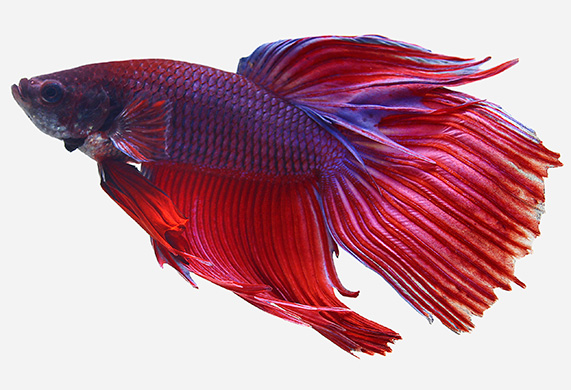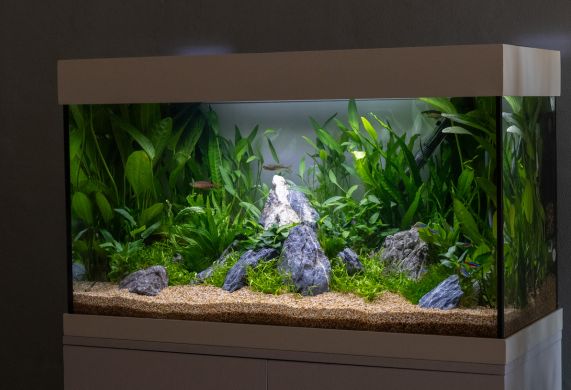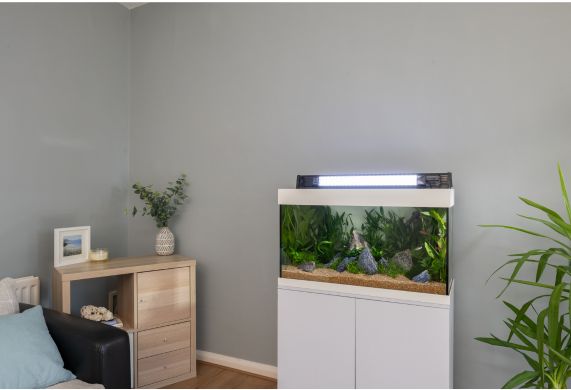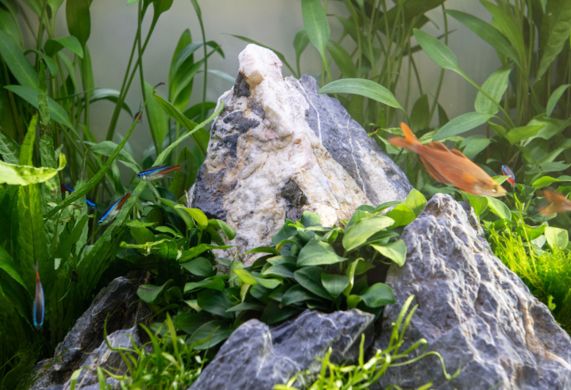Choosing the right aquarium
The first step? Choosing the perfect aquarium to create a safe and beautiful home for your aquatic life. At Interpet, we’re here to make it easy with straightforward advice to help you get started on the right foot.
What Size Aquarium Should You Choose?
The size of your aquarium depends on the fish you want to keep. Larger tanks are usually better, especially for beginners, as they’re easier to maintain and provide more room for fish to thrive. A 60-litre aquarium is a great starting point for most beginners, offering plenty of space for a variety of fish without being overwhelming to manage.
Where to Place Your Aquarium
Choosing the right spot for your tank is crucial for the well-being of your fish. Avoid placing your aquarium in areas with:
- Direct sunlight: This encourages algae growth and creates extra cleaning work.
- Temperature fluctuations: Keep away from radiators, air vents, or draughty windows, as extreme changes can stress your fish.
- Loud noise or vibrations: Stress from noise can lead to health problems for your fish.
Make sure the surface where your tank will sit is stable and can support its weight when filled
Choosing Your Fish
Fish are the stars of your aquarium! When selecting your fish, consider:
- Compatibility: Some fish prefer to live in groups, while others are territorial and need their own space.
- Adult size: Ensure your tank is big enough for the fish to grow to their full adult size.
Research your fish species carefully to understand their needs and ensure they can live harmoniously together.

Why Bigger Tanks Are Better
If space and budget allow, opt for a larger tank. Bigger aquariums:
- Allow you to keep more fish or larger species, giving you flexibility as your hobby grows.
- Dilute waste more effectively, keeping water cleaner for your fish.
- Provide better oxygenation due to a larger surface area.

Aquarium Designs: Style Meets Function
From classic rectangular tanks to modern cylindrical designs, there are plenty of styles to choose from. While aesthetics are important, also consider practical factors like:
- Adequate surface area for oxygen exchange.
- Ease of cleaning.

Essential Equipment for Your Aquarium
Fish keeping does require some basic equipment, at a minimum, you’ll need:
- An aquarium (and a suitable cabinet for stability).
- A reliable filter.
- Aquarium lighting.
- Tap water conditioner.
- A heater (for tropical fish).
Additionally, plan for other essentials such as gravel, plants, a thermometer, a test kit, fish food, and a net. Over time, you may also need additional treatments or tools to keep your tank clean and your fish healthy.
Starting Your Fish Keeping Adventure
At Interpet, we care about your fish and your experience as a fish keeper. With a little preparation and the right equipment you’ll have a thriving, stress-free aquarium in no time. Explore our range of aquariums, accessories, and care guides to get started today!

FAQs
What is the best tank size for a starter aquarium?
For a beginner’s aquarium, it is recommended to start with a size no smaller than 20 Litres, but ideally larger. A 60 Litre aquarium or larger is a great size for those new to fish keeping.
What other equipment do I need to set up a fish tank?
In addition to an aquarium, you will need a filter, heater, thermometer, lighting, substrate and decorations. Depending on the type of fish you keep, you may also need additional water treatments or additives.
What’s the best way to set up a large aquarium?
Setting up a large aquarium can be quite involved and is best done in stages to make sure you are successful.
- Pick an appropriate location for your aquarium. Choose a spot that is out of direct sunlight, not near any heat sources or drafts, and has easy access to electric outlets if needed.
- Place the aquarium on a strong stand that is designed to support the weight of a filled aquarium. It should also provide easy access to electrical outlets if needed.
- Prepare your aquarium by filling it with dechlorinated water and adding any necessary treatments or additives.
- Install the filter, heater, thermometer and lighting as needed for your fish tank.
- Use substrate to cover the bottom of the tank and add decorations like rocks and plants.
- Allow the tank to cycle for a few days before adding any fish. During this time, you can check the water parameters and make sure everything is functioning properly.
- It’s time to add your fish! Make sure you research your fish species beforehand to ensure they are compatible with each other and that you are providing them with the right environment.
What is the best size for a tropical fish home aquarium?
Generally, it is recommended that you choose an aquarium that can hold at least 20 Litres of water. This will provide enough space for your fish to move around and also allow for enough water volume to maintain a consistent temperature and quality of the water.
If you’re looking to start a tropical fish tank, it’s important to know the ratio of fish to water. Generally, 2.5 Litres should be provided for every one inch of fish. This ratio is slightly smaller than that recommended for cold water fish, which is 3 Litres per inch.
How to make aquarium setups stand out?
Creating an aquarium setup that stands out can be a fun and rewarding experience. When selecting the decor for your tank, consider incorporating various textures, colours and shapes. This will help to create a visually appealing display that will be pleasing to both you and your fish.
Adding driftwood, plants, rocks and coral are all great ways to make your aquarium unique. Depending on the type of fish you keep, you may also be able to add live plants or even corals. You can also include ornaments and decorations that are designed to make your tank look like a natural environment.
Finally, consider adding LED lighting to your setup. This will help to bring out the colours of the decorations and make the aquarium stand out.
Does a 35 gallon aquarium need a special stand?
When setting up a 35-gallon aquarium, it’s important to consider the weight it will hold. With water, gravel, filter, and other accessories, the total weight can exceed 135kg. To ensure the safety of your aquarium, you will need a stand that can support the tank without collapsing or wobbling. While it doesn’t have to be a purpose-made aquarium stand, it should be something sturdy and reliable.
For further information, please see our Aquariums & Fish Tank FAQs.